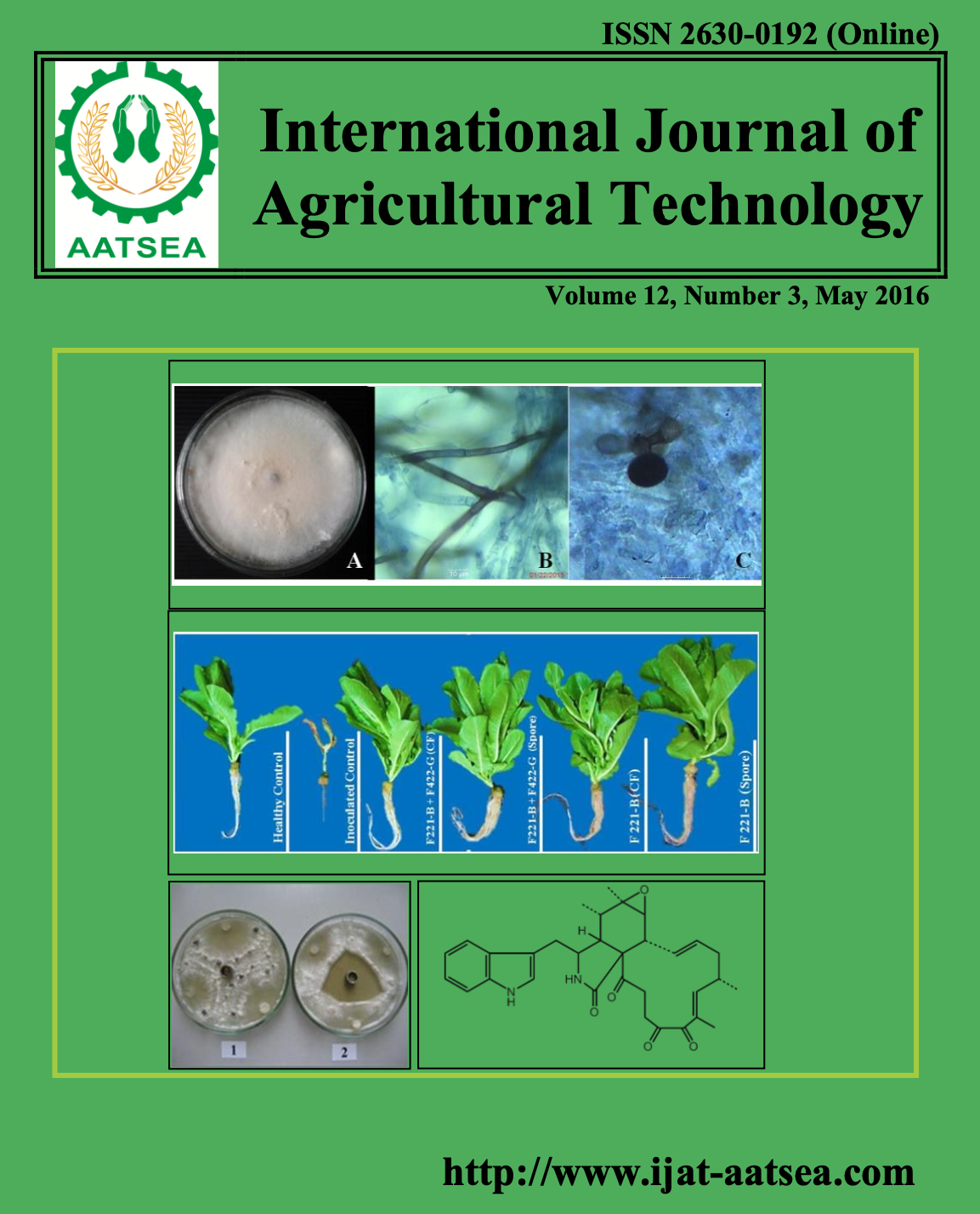The suitable stocking density to growth of macroalgae Spirogyra spp. and its ability of ammonia nitrogen removal
Main Article Content
Abstract
Studying the suitable stocking density to growth of Spirogyra spp. consisted of 5 treatments and 3 replications, Spirogyra spp. was reared in different stocking densities as 0 (control) 1 3 5 and 7 g fw (fresh weight) L-1 for 3 weeks and then studied its ability of ammonia nitrogen removal at the suitable stocking density for 3 days. The results indicated that weight gain and specific growth rate of Spirogyra spp. at all treatments were the highest in the first week of experiment and gradually decreased in the second and the third week respectively which weight gain and specific growth rate of Spirogyra spp. were cultivated at 1 g fw L-1 was higher than control treatment and other treatments. These parameters would decrease when stocking density increase. At the end of experiment, average weight gain and average specific growth rate of Spirogyra spp. rearing at 1 g fw L-1 were higher than other treatments (1.41±3.62 g and 5.57±4.56 %d-1 respectively) and showed significant difference (p<0.05) when compared with the treatments of 5 and 7 g fw L-1 but no significant difference (p>0.05) when compared with 3 g fw L-1 treatment. Finally, the suitable stocking density to growth of Spirogyra spp. in this study was 1 g fw L-1 which showed the best of weight gain and specific growth rate and its ability of ammonia nitrogen removal was 0.045±0.003 mg-N L-1 g fw-1 d-1. In addition, Spirogyra spp. cultivation for 1 week revealed higher product than 2 and 3 week cultivation period.
Article Details

This work is licensed under a Creative Commons Attribution-NonCommercial-NoDerivatives 4.0 International License.
References
Adrien, R. (2011). Characterization of freshwater algae from JKUAT and evaluation of its bioethanol and biodiesel potential. (Postgraduate thesis). Jomo Kenyatta University.
Atawodi, S. E, Uruawuike, S. C., Abdullahi, S. A., Bremauntz, P. and Krupek, R. A. (2015). Evaluation of Spirogyra rhizobrachialis, Merismopedia elegans and Synedra spp. as potential sources of proteases. Annual Review and Research in Biology 5:155.
Eshaq, F. S. (2010). Spirogyra biomass a renewable source for biofuel (bioethanol) production. International Journal of Engineering Science and Technology 2:7045-7054.
Feijoó, C., García, M. E., Momo, F. and Toja, J. (2002). Nutrient absorption by the submerged macrophyte Egeria densa Planch.: Effect of ammonium and phosphorus availability in the water column on growth and nutrient uptake. Limnetica 21:93-104.
Kim, J. K., Duston, J., Corey, P. and Garbary, D. J. (2013). Marine finfish effluent bioremediation: Effect of stocking density and temperature on nitrogen removal capacity of Chondrus crispus and Palmaria palmate (Rhodophyta). Aquaculture 414-415:210-216.
Macchiavello, J. and Bulboa, C. (2014). Nutrient uptake efficiency of Gracilaria chilensis and Ulva lactuca in an IMTA system with the red abalone Haliotis rufescens. Latin American Journal of Aquatic Research 42:523-533.
Mane, P. C. and Bhosle, A. B. (2012). Bioremoval of some metals by living algae Spirogyra sp. and Spirulina sp. from aqueous solution. International Journal of Environmental Research 6:571-576.
Manríquez-Hernández, J. A. (2013). Interaction of irradiance and stocking density on nutrient uptake by red macroalgae implications for bioremediation of fish farm effluents. (Master’s thesis) Dalhousie University.
Msuya, F. E. (2013). Effects of stocking density and additional nutrients on growth of the commercially farmed seaweeds Eucheuma denticulatum and Kappaphycus alvarezii in Zanzibar Tanzania. Tanzania Journal of Natural and Applied Sciences 4:605-612.
Nagler, P. L., Glenn, E. P., Nelson, S. G. and Napolean, S. (2003). Effect of fertilization treatment and stocking density on the growth and production of the economic seaweed Gracilaria parvispora (Rhodophyta) in cage culture at Molokai, Hawaii. Aquaculture 219:379-391.
Peerapornpisal, Y. (2008). Edible freshwater macroalgae in Northern Thailand research. Journal of Fisheries Technology Research 2:178-189.
Peerapornpisal, Y. (2013). Freshwater algae in Thailand Second edition. Chiang Mai: Department of biology, faculty of science, Chiang Mai University.
Pereira, R., Yarish, C. and Sousa-Pinto, I. (2006). The influence of stocking density, light and temperature on the gowth, production and nutrient removal capacity of Porphyra dioica (Bangiales, Rhodophyta). Aquaculture 252:66-78.
Punyoyai, T. (2008). Antioxidant activity of Tao, Spirogyra neglecta (Hassall) KÜtzing. (Master’s thesis). Department of biology, faculty of science, Chiang Mai University, Chiang Mai.
Ramaraj, R., Unpaprom, Y., Whangchai, N. and Dussadee, N. (2015). Culture of macroalgae Spirogyra ellipsospora for long-term experiments, stock maintenance and biogas production. Emergent Life Science Research 1:38-45.
Ren, T. (2014). Primary factors affecting growth of microalgae optimal light exposure duration and frequency. (Master’s thesis). Iowa State University.
Sirirustananun, N. and Chanartaeparporn, P. (2015). Nutrient contents and growth of Spirogyra spp. in water resources of Phetchabun province. Journal of Agricultural Research and Extension 32:58-66.
Thiamdao, S. and Peerapornpisal, Y. (2009). Diversity of edible freshwater macroalgae in Mekong and Nan rivers. Journal of Fisheries Technology Research 3:115-124.
Thiamdao, S and Peerapornpisal, Y. (2011). Morphological observation of Spirogyra ellipsospora Transeau, an edible freshwater macroalgae. Journal of the Microscopy Society of Thailand 4:94-97.
Tipnee, S., Ramaraj, R. and Unpaporm, Y. (2015). Nutritional evaluation of edible freshwater green macroalgae Spirogyra varians. Emergent Life Science Research 1:1-7.
Uthumpa, C. (2011). A comparative study of Spirogyra sp. yield when cultured in plastic buckets with different ratio of inorganic fertilizer (formula 10:25:20). (Master’s thesis). Chiang Rai Rajabhat University.


